Papers by José María Valls

Computing and Informatics / Computers and Artificial Intelligence, 2006
ABSTRACT Radial Basis Neural Networks have been successfully used in many applications due, mainl... more ABSTRACT Radial Basis Neural Networks have been successfully used in many applications due, mainly, to their fast convergence properties. However, the level of generalization is heavily dependent on the quality of the training data. It has been shown that, with careful dynamic selection of training patterns, better generalization performance may be obtained. In this paper, a learning method is presented, that automatically selects the training patterns more appropriate to the new test sample. The method follows a selective learning strategy, in the sense that it builds approximations centered around the novel sample. This training method uses a Gaussian kernel function in order to decide the relevance of each training pattern depending on its similarity to the novel sample. The proposed method has been applied to three different domains: an artificial approximation problem and two time series prediction problems. Results have been compared to standard training method using the complete training data set and the new method shows better generalization abilities.
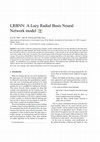
Ai Communications, 2007
In the domain of inductive learning from examples, usually, training data are not evenly distribu... more In the domain of inductive learning from examples, usually, training data are not evenly distributed in the input space. This makes global and eager methods, like Neural Networks, not very accurate in those cases. On the other hand, lazy methods have the problem of how to select the best examples for each test pattern. A bad selection of the training patterns would lead to even worse results. In this work, we present a way of performing a trade-off between local and non-local methods using a lazy strategy. On one hand, a Radial Basis Neural Network is used as learning algorithm; on the other hand, a selection of training patterns is performed for each query in a local way. The selection of patterns is based on the analysis of the query neighborhood, to forecast the size and elements of the best training set for that query. Moreover, the RBNN initialization algorithm has been modifie in a deterministic way to eliminate any initial condition influence The method has been validated in three domains, one artificia and two time series problems, and compared with traditional lazy methods.
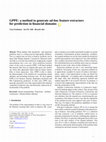
Applied Intelligence, 2008
When dealing with classification and regression problems, there is a strong need for high-quality... more When dealing with classification and regression problems, there is a strong need for high-quality attributes. This is a capital issue not only in financial problems, but in many Data Mining domains. Constructive Induction methods help to overcome this problem by mapping the original representation into a new one, where prediction becomes easier. In this work we present GPPE: a GP-based method that projects data from an original data space into another one where data approaches linear behavior (linear separability or linear regression). Also, GPPE is able to reduce the dimensionality of the problem by recombining related attributes and discarding irrelevant ones. We have applied GPPE to two financial domains: Bankruptcy prediction and IPO Underpricing prediction. In both cases GPPE automatically generated a new data representation that obtained competitive prediction rates and drastically reduced the dimensionality of the problem.
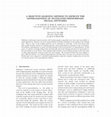
International Journal of Neural Systems, 2001
Multilayer feedforward neural networks with backpropagation algorithm have been used successfully... more Multilayer feedforward neural networks with backpropagation algorithm have been used successfully in many applications. However, the level of generalization is heavily dependent on the quality of the training data. That is, some of the training patterns can be redundant or irrelevant. It has been shown that with careful dynamic selection of training patterns, better generalization performance may be obtained. Nevertheless, generalization is carried out independently of the novel patterns to be approximated. In this paper, we present a learning method that automatically selects the training patterns more appropriate to the new sample to be predicted. This training method follows a lazy learning strategy, in the sense that it builds approximations centered around the novel sample. The proposed method has been applied to three different domains: two artificial approximation problems and a real time series prediction problem. Results have been compared to standard backpropagation using the complete training data set and the new method shows better generalization abilities.

The use of Constructive Induction (CI) methods for the generation of high-quality attributes is a... more The use of Constructive Induction (CI) methods for the generation of high-quality attributes is a very important issue in Machine Learning. In this paper, we present a CI method based in Genetic Programming (GP). This method is able to evolve projections that transform the dataset, constructing a new coordinates space in which the data can be more easily predicted. This coordinates space can be smaller than the original one, achieving two main goals at the same time: on one hand, improving classification tasks; on the other hand, reducing dimensionality of the problem. Also, our method can handle classification and regression problems. We have tested our approach in two financial prediction problems because their high dimensionality is very appropriate for our method. In the first one, GP is used to tackle prediction of bankruptcy of companies (classification problem). In the second one, an IPO Underpricing prediction domain (a classical regression problem) is confronted. Our method obtained in both cases competitive results and, in addition, it drastically reduced dimensionality of the problem.
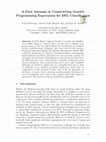
In BCI (Brain Computer Interface) research, the classification of EEG signals is a domain where r... more In BCI (Brain Computer Interface) research, the classification of EEG signals is a domain where raw data has to undergo some preprocessing, so that the right attributes for classification are obtained. Several transformational techniques have been used for this purpose: Principal Component Analysis, the Adaptive Autoregressive Model, FFT or Wavelet Transforms, etc. However, it would be useful to automatically build significant attributes appropriate for each particular problem. In this paper, we use Genetic Programming to evolve projections that translate EEG data into a new vectorial space (coordinates of this space being the new attributes), where projected data can be more easily classified. Although our method is applied here in a straightforward way to check for feasibility, it has achieved reasonable classification results that are comparable to those obtained by other state of the art algorithms. In the future, we expect that by choosing carefully primitive functions, Genetic Programming will be able to give original results that cannot be matched by other machine learning classification algorithms.
It has been shown that the selection of the most similar training patterns to generalize a new sa... more It has been shown that the selection of the most similar training patterns to generalize a new sample can improve the generalization capability of Radial Basis Neural Networks. In previous works, authors have proposed a learning method that automatically selects the most appropriate training patterns for the new sample to be predicted. However, the amount of selected patterns or the neighborhood choice around the new sample might influence in the generalization accuracy. In addition, that neighborhood must be established according to the dimensionality of the input patterns. This work handles these aspects and presents an extension of a previous work of the authors in order to take those subjects into account. A real time-series prediction problem has been chosen in order to validate the selective learning method for a n-dimensional problem.

Radial Basis Neural Networks (RBNN) can approximate any regular function and have a faster traini... more Radial Basis Neural Networks (RBNN) can approximate any regular function and have a faster training phase than other similar neural networks. However, the activation of each neuron depends on the euclidean distance between a pattern and the neuron center. Therefore, the activation function is symmetrical and all attributes are considered equally relevant. This could be solved by altering the metric used in the activation function (i.e. using non-symmetrical metrics). The Mahalanobis distance is such a metric, that takes into account the variability of the attributes and their correlations. However, this distance is computed directly from the variance-covariance matrix and does not consider the accuracy of the learning algorithm. In this paper, we propose to use a generalized euclidean metric, following the Mahalanobis structure, but evolved by a Genetic Algorithm (GA). This GA searches for the distance matrix that minimizes the error produced by a fixed RBNN. Our approach has been tested on two domains and positive results have been observed in both cases.
Usually, training data are not evenly distributed in the input space. This makes non-local method... more Usually, training data are not evenly distributed in the input space. This makes non-local methods, like Neural Networks, not very accurate in those cases. On the other hand, local methods have the problem of how to know which are the best examples for each test pattern. In this work, we present a way of performing a trade off between local and non-local methods. On one hand a Radial Basis Neural Network is used like learning algorithm, on the other hand a selection of the training patterns is used for each query. Moreover, the RBNN initialization algorithm has been modified in a deterministic way to eliminate any initial condition influence. Finally, the new method has been validated in two time series domains, an artificial and a real world one.

Inteligencia Artificial,revista Iberoamericana De Inteligencia Artificial, 2000
Las Redes de Neuronas de Base Radial (RNBR) se comportan muy bien en la aproximación de funciones... more Las Redes de Neuronas de Base Radial (RNBR) se comportan muy bien en la aproximación de funciones, siendo su convergencia extremadamente rápida comparada con las redes de neuronas de tipo perceptrón multicapa. Sin embargo, el diseño de una RNBR para resolver un problema dado, no es sencillo ni inmediato, siendo el número de neuronas de la capa oculta de una Red de Base Radial (RBR) un factor crítico en el comportamiento de este tipo de redes. En este trabajo, el diseño de una RNBR está basado en la cooperación de n+1 agentes: n agentes, cada uno de ellos formado por una RBR, que denominamos agentes RBR y 1 agente árbitro. Estos n+1 agentes se organizan formando un Sistema Multiagente. El proceso de entrenamiento se distribuye entre los n agentes RBR, cada uno de los cuales tiene un número diferente de neuronas. Cada agente RBR se entrena durante un número determinado de ciclos (una etapa), cuando el agente árbitro le envía un mensaje. Todo el proceso está gobernado por el árbitro que decide cuál es el mejor agente RBR en cada etapa. El resultado de los experimentos muestra una importante reducción del número de ciclos de entrenamiento utilizando la estrategia multiagente propuesta, en lugar de una estrategia secuencial.
The Frequency Assignment Problem (FAP) is one of the key issues in the design of GSM networks (Gl... more The Frequency Assignment Problem (FAP) is one of the key issues in the design of GSM networks (Global System for Mobile communications), and will remain important in the foreseeable future. There are many versions of FAP, most of them benchmarking-like problems. We use a formulation of FAP, developed in published work, that focuses on aspects which are relevant for real-world GSM networks. In this paper, we have designed, adapted, and evaluated several types of metaheuristic for different time ranges. After a detailed statistical study, results indicate that these metaheuristics are very appropriate for this FAP. New interference results have been obtained, that significantly improve those published in previous research.
Expert Systems With Applications, 2009
The Robosoccer simulator is a challenging environment for artificial intelligence, where a human ... more The Robosoccer simulator is a challenging environment for artificial intelligence, where a human has to program a team of agents and introduce it into a soccer virtual environment. Most usually, Robosoccer agents are programmed by hand. In some cases, agents make use of Machine learning (ML) to adapt and predict the behavior of the opposite team, but the bulk of the agent has been preprogrammed.
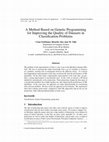
International Journal of Computer Science & Applications, 2007
The problem of the representation of data is a key issue in the Machine Learning (ML) field. ML t... more The problem of the representation of data is a key issue in the Machine Learning (ML) field. ML tries to automatically induct knowledge from a set of examples or instances of a problem, learning how to distinguish between the different classes. It is known that inappropriate representations of the data can drastically limit the performance of ML algorithms. On the other hand, a high-quality representation of the same data, can produce a strong improvement in classification rates. In this work we present a GP-based method for automatically evolve projections. These projections change the data space of a classification problem into a higher-quality one, thus improving the performance of ML algorithms. At the same time, our approach can reduce dimensionality by constructing more relevant attributes. We have tested our approach in four domains. The experiments show that it obtains good results, compared to other ML approaches that do not use our projections, while reducing dimensionality in many cases.

Computing and Informatics / Computers and Artificial Intelligence, 2007
I \~rireless connectivity, mobility support, location awareness, and integration of "vireless net... more I \~rireless connectivity, mobility support, location awareness, and integration of "vireless networks to the Internet are key research challenges in pervasive computing and communications. vVith the advent of inexpensive wireless solutions such as \ViFi, Bluetooth, and ZigBee, a number of challenges arise when these protocols are applied to wireless PAN, home networking, and wireless LANs. This workshop seeks papers describing significant research contributions to the theory, practice, and evaluation of wireless networks for pervasive computing. Exploitation of emerging wireless technologies such as transmit power and rate control, spectral agility, adaptive carrier sensing, cooperative communication as well as application of existing technologies to new applications such as wireless mesh networks and sensor networks are especially welcomed.
Machine Learning techniques are routinely applied to Brain Computer Interfaces in order to learn ... more Machine Learning techniques are routinely applied to Brain Computer Interfaces in order to learn a classifier for a particular user. However, research has shown that classification techniques perform better if the EEG signal is previously preprocessed to provide high quality attributes to the classifier. Spatial and frequency-selection filters can be applied for this purpose. In this paper, we propose to automatically optimize these filters by means of the Covariance Matrix Adaptation Evolution Strategy (CMA-ES). The technique has been tested on data from the BCI-III competition, because both raw and manually filtered datasets were supplied, allowing to compare them. Results show that the CMA-ES is able to obtain higher accuracies than the datasets preprocessed by manually tuned filters.
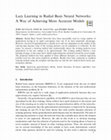
Neural Processing Letters, 2004
Radial Basis Neural Networks have been successfully used in a large number of applications having... more Radial Basis Neural Networks have been successfully used in a large number of applications having in its rapid convergence time one of its most important advantages. However, the level of generalization is usually poor and very dependent on the quality of the training data because some of the training patterns can be redundant or irrelevant. In this paper, we present a learning method that automatically selects the training patterns more appropriate to the new sample to be approximated. This training method follows a lazy learning strategy, in the sense that it builds approximations centered around the novel sample. The proposed method has been applied to three different domains an artificial regression problem and two time series prediction problems. Results have been compared to standard training method using the complete training data set and the new method shows better generalization abilities.
Neurocomputing, 2008
Lazy learning methods have been used to deal with problems in which the learning examples are not... more Lazy learning methods have been used to deal with problems in which the learning examples are not evenly distributed in the input space. They are based on the selection of a subset of training patterns when a new query is received. Usually, that selection is based on the k closest neighbors and it is a static selection, because the number of patterns selected does not depend on the input space region in which the new query is placed. In this paper, a lazy strategy is applied to train radial basis neural networks. That strategy incorporates a dynamic selection of patterns, and that selection is based on two different kernel functions, the Gaussian and the inverse function. This lazy learning method is compared with the classical lazy machine learning methods and with eagerly trained radial basis neural networks.











Uploads
Papers by José María Valls